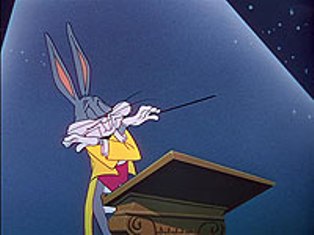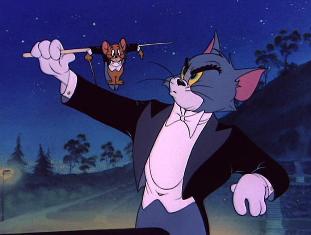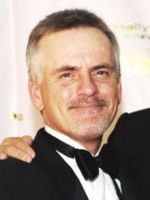
That's How It's Done, Folks!
Many a conductor probably wishes he could emulate the smiling, toothsome
Bugs Bunny when, as pianist par excellence in “Rhapsody Rabbit,” he coolly pulls a gun and shoots the audience
member who coughs just before he applies his pinkies to the keys. Or in "Baton Bunny," where as maestro super-cool, he holds up a sign reading "Thrown the bum out."

Those moments and others in the history of film animation were recalled by the Kentucky Symphony Orchestra led by music director James R. Cassidy Friday night in the Frances K. Carlisle Performing Arts Center at Notre Dame Academy in Covington.
It was a unique program, one that delighted eyes and ears and tickled the funny bone -- all at the same time. Film clips were projected onto a big screen behind the orchestra, which performed the scores live.
Guests with the KSO in recalling a half-century of animated film music were composers Steve and Julie Bernstein (both multi-Emmy Award winners), who discussed their craft with examples shown on screen with simultaneous performance by the KSO, and voice actor Rob Paulsen, who treated the audience to a live encounter with some of his most famous characters. Author and cartoon music expert Daniel Goldmark (author of "Tunes for 'Toons") served as host and moderator.
Rarely has a concert been as stimulating and just plain fun. One learned about the role of music in animated films, the challenge of composing for animation and how music and animation are put together. In the process one could enjoy Bugs, Tom and Jerry, the Pink Panther, Freakazoid, Yakko Warner and Pinky, the last two live, courtesy of Paulsen.
The role of music in animation is to “telegraph the action,” said Goldmark. Animation usually comes first, then the music unless there is a singer who has to mouth words. Composers are given “cues,” i.e. animated clips, as the work progresses before arriving at the finished product.
Several cartoons were screened in full, including “Tom and
Jerry at the Hollywood Bowl,” “Pink Plunk Plink” and “Baton Bunny.” In the first, Tom and Jerry conduct Strauss
waltzes amid all kinds of mayhem as the two maestros try to outdo one
another.

“Pink Plink Plunk” stars the Pink Panther as a would-be violinist who tries to join an orchestra so that he can play his own theme song. “Pink Panther” composer Henry Mancini is shown applauding live at the end. As for “Baton Bunny,” Bugs is as choreographic as a conductor could ever wish to be and more, even conducting with his ears.
The concert opened with an excerpt from -- what else? -- Liszt’s Hungarian Dance No. 2. This ubiquitous classic was first used in an animated film in “Rhapsody in Rivets” in 1941 about work on a construction site. Producer Fritz Freleng became so fond of it that he used it again in “Rhapsody Rabbit,” with Bugs as a concert pianist. This was also the first time Bugs squelched a cougher with a pistol, said Goldmark.
The Bernsteins, composers for Steven Spielberg’s “Animaniacs” series, presented cues from their films to illustrate how composing for animation is done. One of the biggest challenges is the rapid, constant change of mood in animated films. Another is being careful not to cover up the dialogue.
There are some more or less “stock” devices, they explained, such as using the xylophone for blinks of the eye, bassoon for footsteps and string glissandos (sliding up and down the string) for opening a door. As an example of a classic animation sequence, Cassidy led the KSO in “Powerhouse” by Raymond Scott, prototype for locomotives and technology “run amok.”
Since much of cartoon animation involves parody, including other people’s music, composers must be careful to avoid “being sued,” said the Bernsteins. Copyright infringement can be a problem unless something is already in the public domain. To illustrate how this is done (carefully), cues from some of their “Animaniacs” episodes were shown and performed, including “Vernal Ritual” (Stravinsky’s “Rite of Spring” with dinosaurs, but not of the Disney “Fantasia” kind). Another was the superhero Freakazoid running from a pterodactyl, as in Hitchcock’s “North by Northwest” (Bernard Hermann). Steven Bernstein described “West Side Pigeons,” a parody of Leonard Bernstein’s “West Side Story,” as “Bernstein (pronounced BERN-STEEN) on Bernstein.”
Paulsen delighted the audience with his “voices”—and with his
stage presence, since he is quite captivating in the flesh. Before intermission, he was Pinky (of “Pinky
and the Brain”) in “Cheese Roll Call” to music by Steve Bernstein (influenced
by John Philip Sousa). That’s cheese as
in Gouda, with varieties from around the world stepping up to the microphone to
introduce themselves. He was also Yakko
in “Yakko’s Universe” and “Yakko’s World" (both orchestrated by Julie Bernstein). In the latter, where he made
a geographic survey of the world, he showed that he can sing a “patter aria” (machine-gun
fast) with the best of them.

To sum up the lessons of the evening – a kind of “Animation 101” – Steve Bernstein led the KSO in the Tom and Jerry cartoon, “Kitchen Chase.” As the name implies, it was rapid-fire, one thing after another in sync with Tom and Jerry, and very difficult to play. One is never sure whether cat or mouse wins in these encounters, but the KSO certainly did here.
Cassidy led a final “Cartoon Theme Medley” arranged by Terry LaBolt. Some of the great animation theme songs heard here included “The Jetsons” and “The Flintstones”) (Hoyt Curtin), “Popeye” (Sammy Lerner), “Rocky and Bullwinkle” (Frank Comstock) and, of course, “Merrily We Roll Along” (Charles Tobias).
The concert repeats at 8 p.m. Saturday (May 15) at Notre Dame Academy, 1699 Hilton Drive in Covington, Kentucky. Tickets are $28 and $23 with discounts for seniors and students, at the door, or call (859) 431-6216. Information at www.kyso.org